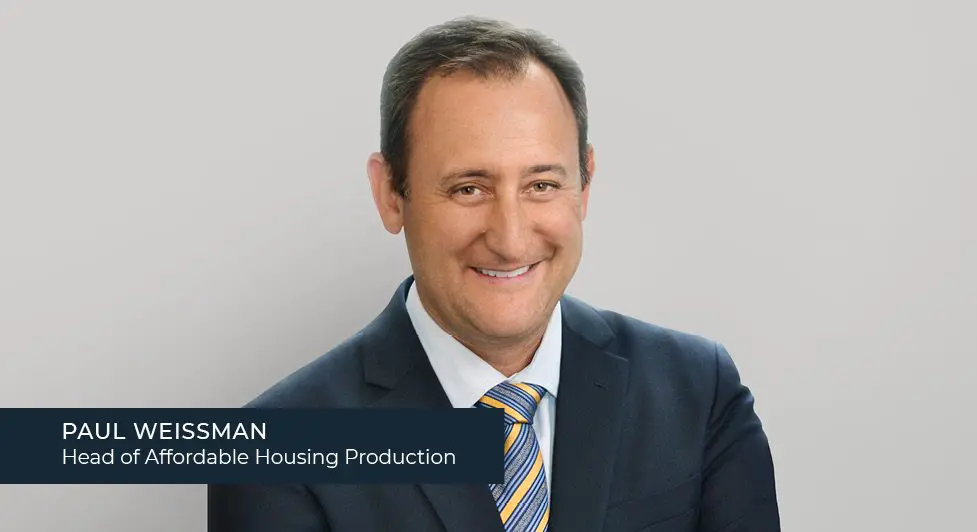Soaring construction, labor, and insurance costs, NIMBYism and restrictive zoning, limited LIHTC funding, and interest rates at 40-year highs. These are just some of the factors that have made developing and preserving affordable housing especially demanding at a time when the need is more pressing than ever. According to the National Low Income Housing Coalition, there is a shortage of over seven million homes for extremely low-income families alone.
Finding a way to close that gap—aligning business prerequisites with the moral imperative to provide safe, clean, comfortable housing—will take creativity, expertise, and no small amount of trial and error. Exposure to new ideas and fresh perspectives can only accelerate the process.
It was in this context that we asked affordable housing expert Carol Galante and developer Bobby Byrd to join us on May 9 for our most recent Lument In Conversation webcast: Finding a Future for Affordable Housing.
The founder, advisor, and emeritus faculty director of the Terner Center for Housing Innovation at U.C. Berkeley, Carol has a unique combination of policy and business experience. During her five years at HUD, she served as assistant secretary for housing/federal housing commissioner as well as deputy assistant secretary for multifamily housing programs. Before that, she was president and chief executive of BRIDGE Housing Corporation, the largest nonprofit developer of affordable, mixed-income, and mixed-use developments in California.
Bobby is a managing partner for development at Fairstead, a vertically integrated national real estate developer. He is responsible for the company’s affordable housing platform and oversees its workforce housing, affordable GP interest, and Midwest and West Coast LIHTC business lines.
Their conclusion: There is no single silver bullet that will solve the nation’s affordable housing crisis. It will take incremental change and innovative thinking in virtually every area—zoning, LIHTC financing, and section 8 requirements among them—to build the necessary momentum to make affordable housing available to all.
Here are the highlights of our discussion.
Learning from the Present
A first step in building a robust pipeline for affordable housing is to take a closer look at developers’ creative responses to the constraints they deal with today. In addition to higher interest rates and rising costs, the string of bank failures in 2023 may slow transaction timelines by constraining credit. This could happen in several ways, noted Carol. Going forward, industry consolidation may mean fewer regional banks for developers to work with. Fewer regional banks will also mean less local expertise. As a result, credit could become harder to come by for developers, while financing options may become less flexible, too,
As a result, companies like Fairstead are becoming more careful about the projects they pursue. “Lenders are more cautious, debt is more expensive, and proceeds are smaller,” Bobby said. “We have to be much more selective to make sure we are able to secure the resources necessary to have the impact we would like.”
And because time is money, speed has become more important in their calculations. Bobby noted, for instance, that because bridge financing has become more expensive and less available, Fairstead has had less leeway in how long it can carry a project.
The result is that developers are looking harder than ever to find ways to compress the acquisition and construction cycle and cut costs at every step of the way.
Given these and other constraints, said Carol, a surge in housing innovation will be needed to build more cheaply and efficiently. One promising example—already common in Japan and the U.K.—is modular construction, whereby a building’s different components are built at a factory and then transported to the housing site for assembly.
“Conventional construction not only costs more but takes longer to complete,” she said. “With prefab, you can be building your units in the factory while you’re completing your site work, reducing carrying costs as well as construction fees.” She cautioned, however, that realizing savings from modular means designing for modular from the start.
Bobby noted a number of other strategies that Fairstead has employed to trim its development timeline and cut costs. For instance, it has partnered with market-rate developers with entitlements whose projects have stalled and is even considering converting a conventional development to a LIHTC transaction.
But he noted that several conditions must be aligned for this strategy to work. “This is hardly pick and run,” he said. “You’ve got to have support at the state and local level to get these done—and the original design has to be flexible enough that it can be adapted to meet affordable housing requirements.”
Accelerated Transaction Timelines
Bobby believes a more productive and far-reaching approach to compressing timelines and costs would cut through a fundamental obstacle that sucks time and money out of a deal: the overlapping and sometimes conflicting underwriting and design regulations that come with assembling an affordable housing capital stack.
Carol concurred, observing that it is not just aggregating the capital stack that is costly; it is managing it. She noted that the Terner Center has done studies that demonstrate that each layer of financing or equity adds substantially to a project’s cost. “By the time you’ve accumulated the necessary capital stack commitments, your construction costs have increased by 25%, and you have to start all over again aggregating capital.” She pointed out that some localities, like Minneapolis-St. Paul, have worked with the state to better standardize and simplify requirements. Their idea is to eventually have a one-stop shop for approvals.
A New Vision for LIHTC
While accelerating transactions would give affordable housing developers the leeway to pursue deals that might otherwise be out of reach, both Bobby and Carol agreed that changes to the LIHTC program designed to dramatically expand the universe of deals would be the most effective way to jumpstart the creation and preservation of affordable housing. The Affordable Housing Credit Improvement Act would increase the size of the LIHTC program by 50% and, by lowering the threshold of tax-exempt bond financing available to an individual property from 50% to 25%, it would free them up to be used for more transactions.
But while there is substantial bipartisan support for these reforms, the act has been stalled in Congress for a number of years and prognosis for its passage is uncertain. “Given the current political environment and the divided Congress, I am not optimistic,” Carol said. “It is just not a priority for most representatives right now.”
At the same time, Bobby expressed concern about the unintended consequences of enacting such a blanket change, based on what he has observed in states like Georgia, where the increase in 4% volume has grown exponentially over the last five years. Expanding the pipeline of LIHTC transactions without giving allocating agencies the resources to process the deals could overwhelm the system. “The net result might be increased competition for available credits,” he said.
A More Equitable Distribution
Building more units is one answer to the affordable housing crisis. Making sure those units are built in the right places is an equally important consideration. “Public housing, Section 8 housing, and most of LIHTC housing is in poor neighborhoods,” Carol observed. “We have made neighborhoods poorer by putting more poor people in them. But it is really hard to reverse that trend by building affordable housing in higher income areas. There are so many layers of complications, and so it is hard for state agencies and local governments to get this right.”
Consider San Francisco, a NIMBY epicenter. In 1950, the city’s population was roughly 20% African-American; today, it is only 5%. “How do you deal more effectively with the NIMBY movement, to provide greater opportunity and to ensure that public dollars are not furthering segregation?” asked Carol. “It’s a moral imperative to address this challenge.”
Bobby noted that one unforeseen outcome of qualified action plans that promote more inclusionary affordable housing is that, in many areas, they effectively encourage the creation of smaller communities with 40 to 50 units. As they reach the end of their 15-year compliance periods, Bobby explained, there is a real risk that they could exit the program. These communities, originally financed with 9% tax credits, are typically too small for bond financing and are eligible only for the 4% tax credit available for rehabilitation. “At 4%, these communities are not sustainable,” Bobby said. “There is a real risk that these preservation opportunities will be lost.”
The Road Ahead: Incremental Change
It was clear from our discussion that Carol and Bobby share the consensus view that resolving the affordable housing crisis will require changes from several quarters, whether they entail adjustments to the regulatory regime, technological improvements like modular construction, or simply greater collaboration on the state and local levels. It is equally clear that all these changes will need to be monitored and reassessed, often over a period of decades, to make sure they have the desired effects with a minimum of unintended consequences. “Finding the right mix is a difficult problem—and there is certainly no one-size-fits-all answer,” Carol concluded. “But we have an obligation to continue working on this until we free up the logjam in affordable housing.”
Watch the webcast recording Finding a Future for Affordable Housing

